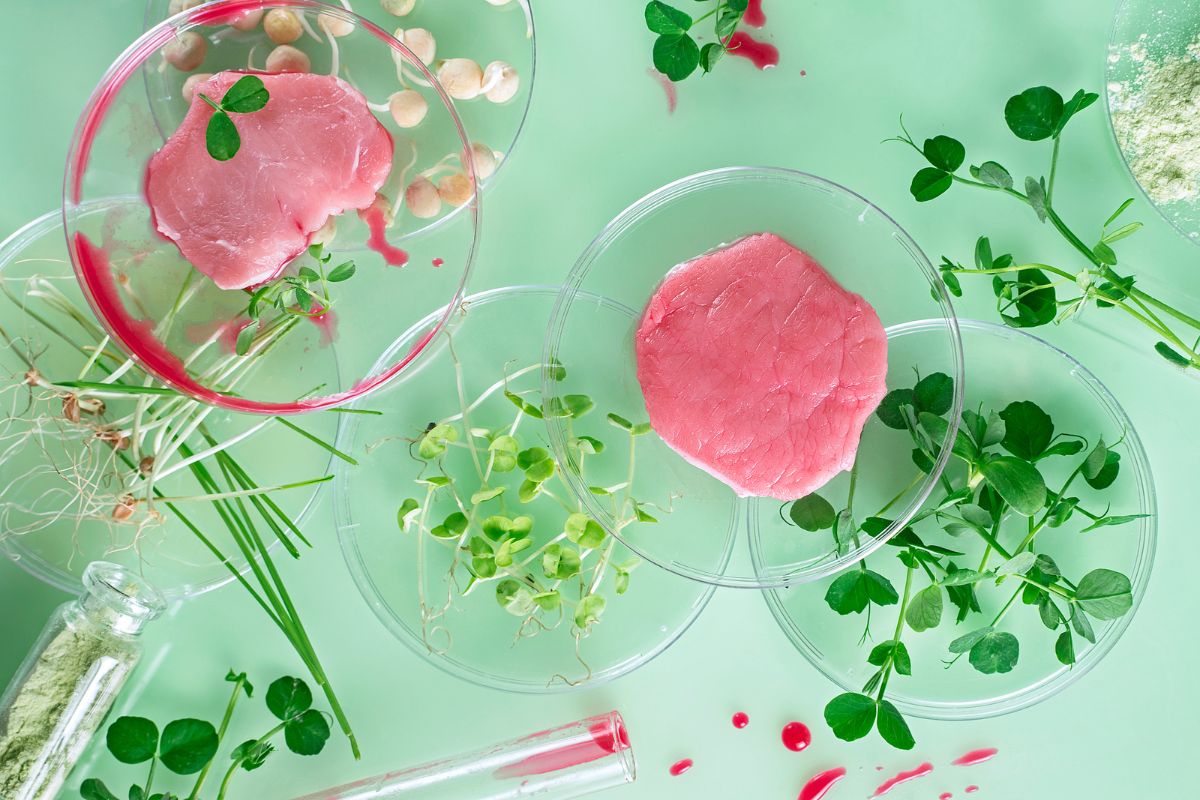
Futuristic Fantasy to Factory. Has Cell-Based Meat Truly Arrived?
From fantasy to factory within the last couple of years, innovation in cell-based meat has rapidly improved. Mainstream media is awash with headlines proclaiming the arrival of cultivated steak, meatballs, and nuggets. Amongst plant-based businesses, debates have begun in earnest about the labelling of cell-based products and how they fit alongside their plant-based counterparts.
Although not plant-based, the companies operating in this new category share some of the goals and ambitions of plant-based foods and will likely appeal to similar consumers. A 2018 Harvard study found that Attitudes towards the environment appear to be one of the most important determinants of consumers’ consumption behaviour and new food acceptance and that consumers with environmental concerns were more willing to purchase meat alternatives, such as plant-based and cultured meat. A 2022 study by the UK Food Standards Agency found that a third of UK consumers were willing to try cultivated meat, with sustainability cited as the main reason. Of those who said they would not, over a quarter said they could be persuaded if they knew it was safe.
For consumers concerned about animal welfare, environment and health, cultured meat performs better than animal meat on all fronts. An animal is only used at the very start of the process. Far less land and resources are needed than in traditional animal agriculture and the product will undoubtedly be free of the hormones and antibiotics that intensive animal farming requires.
So while not plant-based, cultured meat is of immense interest to the plant-based business community, and following its progress is crucial for understanding the opportunities and threats it poses. These will likely become more pressing as products go through the various stages of development, scaling, and approval, which will eventually bring them to market.
To discuss the issues around cultivated meat the Good Food Institute (GFI) held a webinar in February 2023 to review the status of the cultivated meat industry and examine recent advances in the US.
The discussion was timely because cultivated meat is reaching some critical milestones. Companies are moving from the lab to the bioreactor stage, attracting serious investment, and gaining approval from national authorities. Cultivated meat took a major step forward in November 2022 when US company Upside Foods got approval from the US Food and Drug Administration (USFDA)that its cultivated chicken breast is safe for human consumption. Upside still needs the go-ahead from US Department of Food Safety and Inspection Service, but the company says it is hoping to bring products to restaurants by 2023 and to supermarkets by 2028. Other companies are seeking FDA approval. California-based Good Meat has an application pending. And Two others, Netherlands-based Mosa Meat and Israel-based Believer Meats are in discussions with the agency. This follows Good Meat getting the go-ahead for the commercial sale of two of its cultivated chicken products in Singapore.
There are reported to be around 90 companies working in the cultivated meat space and some are investing heavily in manufacturing. In Wilson, North Carolina, the world’s largest cultivated meat factory is being built by Israeli start-up Believer Meats. It will be capable of producing 10,000 tonnes of meat a year. UK Ivy Farms is planning a factory capable of producing at least 12,000 tonnes of cultivated meat. It already runs an R&D facility that can produce three tonnes per year. And in Australia Vow has unveiled a factory capable of producing 30 tonnes per year, ahead of regulatory approval.
Investment into the sector has also grown significantly. In November 2022 Research and Markets reported that $1 billion was invested during the past 12 months. In 2020 more than $360 million was invested, six times more than in 2019. Investors include big meat companies like Tyson Foods, JBS and Cargills. Investment has also come from wealthy individuals such as Bill Gates and Richard Branson.
Emma Ignaszewski is the Associate Director of Industry Intelligence and Initiatives at GFI. At the recent GFI webinar on cultivated meat, she explained: “All of the largest six meat companies are involved in cultivated meat – either through acquiring companies, investing in companies, or starting their own range. JBS the largest meat company in the world has acquired a cultivated meat company and has announced the establishment of an R&D centre, saying it intends to bring cultivated meat to market by 2024.”
Much has been made of the “yuck factor” as a barrier to consumer acceptance. Despite the argument that a bioreactor process is less messy than conventional meat production, there is a worry that consumers will be squeamish about this except this unconventionally produced food. However, research commissioned by the GFI in December 2022 suggests these fears may be unfounded. The survey of over 1000 adults found that after the technology was explained, support for cultivated meat increased. This suggests consumer education will be very important for uptake. The aspect of cultivated meat that most appealed to consumers was the health advantage – the lack of hormones, steroids, antibiotics, and lower risk of foodborne illnesses and zoonotic diseases. 45% said they would try cultivated meat and 20% said they would buy it, which is a very promising result for something they have not seen or tasted.
Emma Ignaszewski told the webinar that one exciting aspect is the potential for hybrid products. One of the main barriers to consumers eating more plant-based food today is the sensory gap – that meat substitutes don’t match the tastes and textures that they are used to. Mixing cultivated meat with other plant proteins is a chance to improve the experience for consumers. “While we are in the early stage there is a chance to experiment. For example, a company could mix cultivated protein with plant-based fat. There will be products with the taste and texture of meat but the health benefits of plant-based products. Some companies have already announced products in that vein.”
One barrier to getting accepted by vegan, vegetarian and ethical consumers, has been the use of Foetal Bovine Serum (FBS). This used to be considered necessary for turning stem cells into muscle. However, in January 2022 Mosa Meat announced that it had replaced FBS with a non-animal substitute.
Faraz Harsini MSc PhD is a bioprocessing senior scientist at the GFI, and an expert on scaling up the cultivated meat industry. He is also the CEO of the non-profit Allied Scholars for Animal Protection. In the GFI webinar, he explained: “The supply for FBS is very limited globally and using FBS is a huge problem. It is in everyone’s interest to come up with an alternative. We don’t have a lot of information about what cultivated meat companies are using but we know that most now use substitutes.”
In answer to the ethical question of whether cultivated meat is vegan, Faraz Harsini told Pulse that its development will undoubtedly lead to less suffering for billions of non-human animals: “Veganism is reducing the harm caused to animals. If cultivated meat reduces the demand for billions of pounds of animal flesh, then it is surely beneficial to the animals who weren’t forced to be born and later killed for their flesh.
Cultivated meat research and technology also have a magnificent potential for replacing other animal products commonly used in pharmaceutical companies and biomedical research. This includes replacing FBS or advancing the tissue engineering field to replace animal testing.
Is it vegan in the sense that no one was harmed in its making? The original sample still comes from an animal. But it is possible to take it from the tip of a feather or a small biopsy or blood sample. Once a cell line is established, there will be no need to go back to the animal. All further cultivated meat production will start from cells grown in culture and frozen in cell banks. The harm and inconvenience for the animals involved is far less than for animals harmed or displaced in agricultural practices.
If the criteria is “absolutely no harm caused to anyone or anything”, then no one is really vegan, because we’re always causing harm knowingly or not to some level. But if the criteria is minimizing harm to non-human animals as much as possible and practical, then on that metric, cultivated meat would spare the lives of billions of non-human animals and will facilitate our transition from here to a world where animals are no longer raised, harmed, and killed for food!”
Faraz Harsini is optimistic about the ability of the sector to reach the market in the next few years at a price that consumers will accept: “While there are degrees of uncertainty, we expect that by the end of this decade, cultivated meat can reach price parity, at least with luxury products. To enable scaling up and making cultivated meat as cheap as possible it will be crucial to develop better bioreactors. There is a huge opportunity for start-ups to build bioreactors specifically for cultivated meat.”


